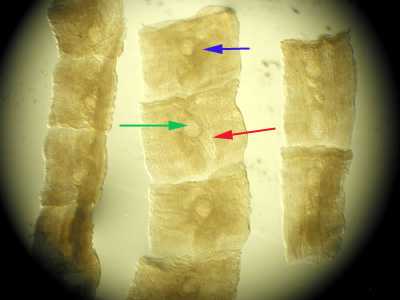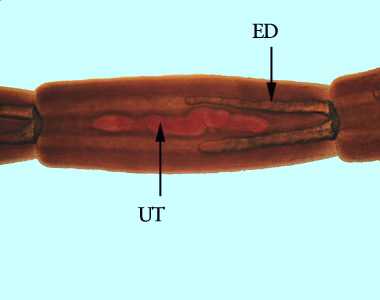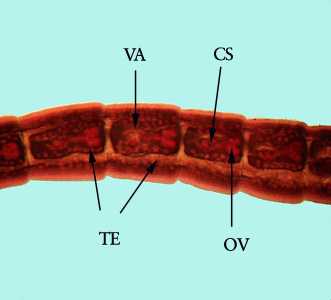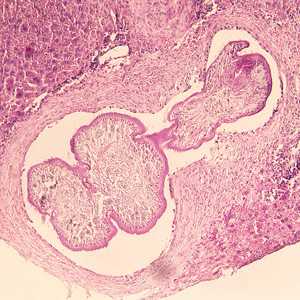
Mesocestoidiasis
[Mesocestoides spp.]
Causal Agents
Cestodes in the genus Mesocestoides; M. lineatus and M. variabilis have been reported to infect humans.
Life Cycle

Mesocestoides spp. require a three-host life cycle to complete their development. The definitive hosts are primarily carnivores, including canids, felids and mustelids. Gravid, motile proglottids are shed in feces . Within the proglottids, hundreds of oncospheres are contained within the parauterine organ
. Within the proglottids, hundreds of oncospheres are contained within the parauterine organ . The first intermediate host is presumed to be an arthropod
. The first intermediate host is presumed to be an arthropod , and becomes infected after eating proglottids or oncospheres. Several arthropods have been looked at as potential first intermediate hosts for Mesocestoides spp, including ants and oribatid mites; however, none of these species have been demonstrated in nature to serve as an intermediate host. In the first intermediate host, it is believed the oncosphere develops into a second-stage larva (cysticercoid or procercoid). When the first-intermediate host is eaten by a second intermediate host, including small mammals, birds, reptiles and amphibians
, and becomes infected after eating proglottids or oncospheres. Several arthropods have been looked at as potential first intermediate hosts for Mesocestoides spp, including ants and oribatid mites; however, none of these species have been demonstrated in nature to serve as an intermediate host. In the first intermediate host, it is believed the oncosphere develops into a second-stage larva (cysticercoid or procercoid). When the first-intermediate host is eaten by a second intermediate host, including small mammals, birds, reptiles and amphibians , the second-stage larva develops into an infective, third-stage larva (tetrathyridium). Domestic and wild canids, which usually serve as the definitive host, may also serve as dead-end intermediate hosts upon ingestion of infected first intermediate hosts. The definitive host ultimately becomes infected after eating meat contaminated with tetrathyridia
, the second-stage larva develops into an infective, third-stage larva (tetrathyridium). Domestic and wild canids, which usually serve as the definitive host, may also serve as dead-end intermediate hosts upon ingestion of infected first intermediate hosts. The definitive host ultimately becomes infected after eating meat contaminated with tetrathyridia . Upon ingestion, the cestode settles in the small intestine where it matures. Gravid proglottids can be seen in the stool as early as two weeks. Humans are not usual definitive hosts, but can serve as such after eating undercooked meat containing tetrathyridia
. Upon ingestion, the cestode settles in the small intestine where it matures. Gravid proglottids can be seen in the stool as early as two weeks. Humans are not usual definitive hosts, but can serve as such after eating undercooked meat containing tetrathyridia  .
.
Geographic Distribution
North America, Europe, Asia and Africa; M. lineatus is an Old World species; M. variabilis is North American.
Clinical Presentation
Mesocestoides species usually parasitize humans in low numbers, causing mild gastrointestinal symptoms: nausea, diarrhea, abdominal discomfort, vomiting.
Mesocestoides spp. proglottids and scoleces

Figure A: Proglottids of Mesocestoides sp., collected from the stool of a dog.

Figure B: Higher magnification of the proglottids in Figure A, showing the uterus (red arrow), ovary (blue arrow) and parauterine organ (green arrow).

Figure C: Gravid proglottid of Mesocestoides sp. stained with carmine. Shown in this specimen are the uterus (UT) and excretory ducts (ED).

Figure D: Mature proglottids of Mesocestoides sp. stained with carmine. Shown in this specimen are the vagina (VA), cirrus sac (CS), bilobed ovary (OV) and numerous testes (TE).

Figure E: Scolex of Mesocestoides sp. stained with carmine. In this field, two of the suckers are clearly visible. Note that lack of rostellar hooklets.
Mesocestoides spp. tetrathyridia.

Figure A: Tetrathyridium of Mesocestoides sp. in the liver of a laboratory-infected mouse.
Laboratory Diagnosis
The diagnosis is based on the microscopic identification of proglottids and eggs in the stool. Mature proglottids need to be differentiated from Dipylidium caninum; immature proglottids may be difficult to differentiate from Diphyllobothrium spp.
Treatment Information
Human infections with Mesocestoides spp. are rare; approximately 30 cases of human infection have been reported worldwide and ten cases have been reported in the United States from 1942-2009. Infection has been treated successfully with a single oral dose of praziquantel, 10 mg/kg. Praziquantel is not approved for treatment of children less than 4 years old but children as young as 19 months have been successfully treated with praziquantel. Niclosamide is effective but is not available in the United States.
DPDx is an education resource designed for health professionals and laboratory scientists. For an overview including prevention and control visit www.cdc.gov/parasites/.
- Page last reviewed: May 3, 2016
- Page last updated: May 3, 2016
- Content source:
- Global Health – Division of Parasitic Diseases and Malaria
- Notice: Linking to a non-federal site does not constitute an endorsement by HHS, CDC or any of its employees of the sponsors or the information and products presented on the site.
- Maintained By:


 ShareCompartir
ShareCompartir